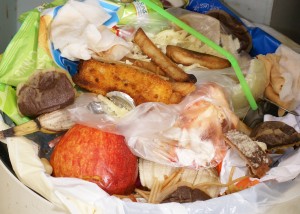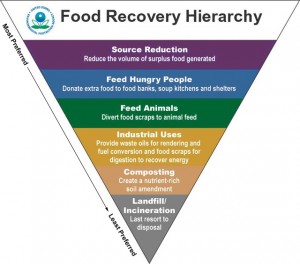Feed People, Not the Garbage
By Jenn DeRose, Green Dining Alliance
America wastes a lot of food. It has been estimated that 40 percent of food in this country gets tossed every year. If you’re wondering how to interpret that number, imagine taking nearly half of every meal you eat and dumping it directly in the garbage. Now imagine 318 million of your neighbors doing exactly the same thing.
 Wasting that much food translated into 37 million tons of garbage in 2013, garbage that could’ve had a different fate as nourishment for hungry people. One in seven Americans are food insecure, which means they do not know where their next meal will come from, if they get a next meal.
Wasting that much food translated into 37 million tons of garbage in 2013, garbage that could’ve had a different fate as nourishment for hungry people. One in seven Americans are food insecure, which means they do not know where their next meal will come from, if they get a next meal.
The Green Dining Alliance (GDA) has always encouraged our member restaurants to minimize their food waste by reducing portion sizes and composting food waste. So when we heard that EPA was co-leading a new initiative to reduce U.S. food waste by 50 percent by 2030, we had to get involved. The GDA joined EPA’s Food Recovery Challenge as an Endorser, promoting the challenge by suggesting our members to join up as Participants.
Food Recovery Challenge Participants are given tools to measure how much food they’ve saved from landfills, including ways to measure how much they’ve reduced their environmental footprint. They are taught to use the Food Recovery Hierarchy as a template for how to best reduce their food waste.
 We have a few food-reduction superheroes in our membership. For example, one Asian restaurant has an all-you-can-eat buffet with a twist. It is served Dim Sum style – you are offered small portions of everything on the menu. If you want more, you have to ask for it. You can have as much as you like, but you don’t get more than you need, reducing the waste that is typical of buffets.
We have a few food-reduction superheroes in our membership. For example, one Asian restaurant has an all-you-can-eat buffet with a twist. It is served Dim Sum style – you are offered small portions of everything on the menu. If you want more, you have to ask for it. You can have as much as you like, but you don’t get more than you need, reducing the waste that is typical of buffets.
We are also proud of our members who compost, which diverts more waste from the landfill and reduces more methane (greenhouse gas emissions) than those who are only recycling. Pound for pound, the comparative impact of methane on climate change is more than 25 times greater than carbon dioxide over a 100-year period.
Luckily, reducing food waste in your own home is easy. You can use the Food Recovery Hierarchy to get ideas for best practices, like buying less food. Start an audit or mental checklist of the foods you end up throwing away. Do broccoli or potatoes always seem to go bad before you get to cooking them? Consider buying less to start with, or freezing meals and ingredients for later – that’s “source reduction.”
Let your nose check for the freshness of items with expiration dates for which there are no national guidelines (except for baby formula). These dates are set by industry to ensure that customers buy only the very freshest products. This practice unfortunately contributes greatly to food waste, as customers fear that products past the “best by” or “sell by” dates might harm them.
Home composting is also an easy way to keep food out of landfills. Start a pile in your backyard for eggshells, coffee grounds, vegetable trimmings and more.
Food makes up 18 percent of the waste in landfills, contributing 18 percent of our methane emissions. Small steps can make a big difference when fighting the scourge of wasted food. Do your part by visiting GDA restaurants, asking more restaurants to compost, composting at home, ignoring “best by” labels, buying only what you can eat, and eating all you buy.
If America is to cut its food waste in half by 2030, and meet EPA’s Food Recovery Challenge goal, more individuals and industries will have to get aboard the food waste recovery train. Let’s all do our part!
About the Author: Jenn DeRose is program manager of the Green Dining Alliance, a program of St. Louis Earth Day. The GDA is a certification program for restaurants to assess and improve their sustainable practices, including reducing their waste, water, and carbon footprint. Jenn has doubled the GDA’s size in less than a year, now at over 100 members. Jenn is a writer and a LEED Green Associate, and is earning a bachelor’s degree in sustainability at Washington University. She enjoys camping, foraging, birdwatching, and cycling.


Oct 25, 2016 @ 07:14:03
There are plenty of ways to make use of domestic waste for good purposes. One of them is learning how to compost. It is truth that small steps make big difference, especially when it comes to handling the personal household waste maintenance.
Oct 31, 2016 @ 17:33:20
UNITED STATES IS WASTING A LOT OF FOODS. IT IS ESTIMATED FORTY PERCENT FEED IS TOSSED EVERY YEAR.